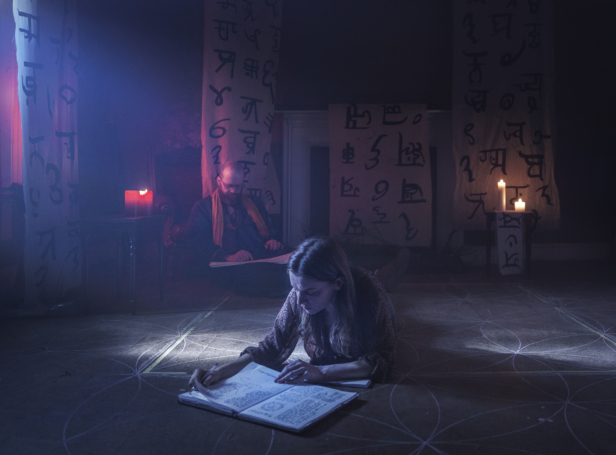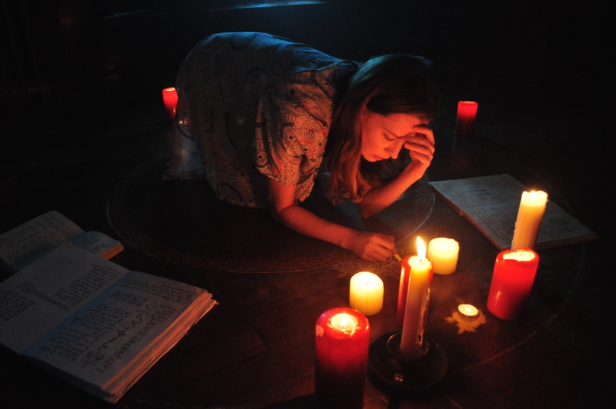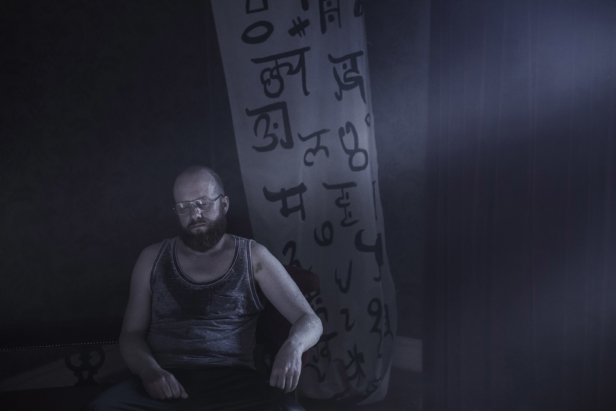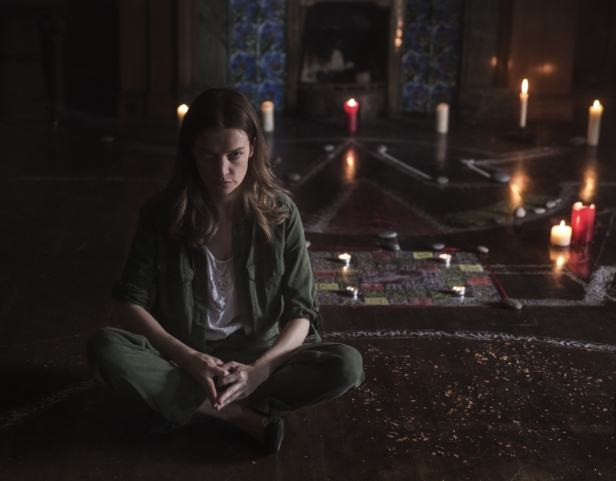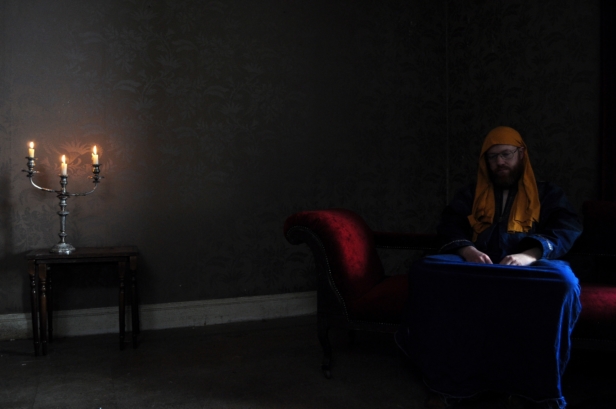We’ve all seen black magic rituals in films. A pentagram here, a few candles there, and a bit of chanting. Simple, right? Well, that’s definitely not the case in Liam Gavin’s excellent debut A Dark Song. This slow-burn chiller follows a desperate woman (Catherine Walker) and a bullying occultist (Steve Oram) as they barricade themselves inside a country house to enact a powerful ritual. As the days and weeks drag by, the sacrifices become greater and more painful, but something does seem to be happening…
We talked to Gavin about his inspirations and influences, finding the film’s powerful tone and blending social realism and horror.
How did A Dark Song come about?
Well, the initial idea of the film came conceptually. I was talking to a development person who was decrying the fact that all horror films now are about vampires and possessions and zombies, and said “No one is thinking of anything new.” And then I saw a documentary about Aleister Crowley and he carried out the actual ritual that you see in the film in Scotland. It’s longer in real life than it is in the actual film, bizarrely, he got bored halfway through and walked out. They’re going to knock that house down. Jimmy Page owned it at some point. But I remember thinking that the ritual was really suitable bonkers and what’s more it was all done in one house. That made it a sort of affordable bonkers thing to do! So it grew from there really.
Had you always concieved it as being this very detailed, methodical portrayal of the occult?
I went through a bizarre occult phase when I was about 13, 14, as you do, I went to a Catholic school and you’re in that world anyway. It was a very brief period, after about 6, 7 months you grow out of these things, like flick-knives or something like that. But I knew that the occult wasn’t what people thought it was, so what I wanted to do was basically do it as kind of a social realist piece. That, if you were to go about doing this, this is the kind of thing you should expect along the way, and for most people who do practice such things, it’s as much about the journey as it is about the result.
So did the slow-burn element come naturally from that?
Well yeah that’s it, because the film, I’m absolutely insane for doing it, I suppose, is about a wait, you know? It’s sitting down and trying to get something done, rather than setting off a series of fireworks. For me it’s a sort of reaction to the jump scare films that have gone on for the last few years. Doing something that’s about atmosphere and about build, and it is a pressure cooker. I liken it to having someone stand directly behind you all the time.
I also wanted to shift it into a character-based thing, which often gets lost when you’re trying to do jump scares, which is about manipulating the audience into a certain position. So you almost feel like you’re in there with the characters. You’re a third character.
How did the characters develop as the writing progressed?
In the very first draft, both characters were very different. Catherine’s character Sophia was initially a 17, 18-year-old girl whose brother had died and she employed this occultist to get this ritual done as well, but the occultist at that stage was a slightly more kindly version of what you get today. But the first thing we changed was making Sophia older. When she was 17 it was an unequal relationship but we bolstered her up to be in her 30s, and then they’re equals. She’s dealing with this aggressive man but she’s not really that scared of him at any stage.
He started off kindly and we decided in the development process that we wanted to make her really feel the pressure from every side, particularly from him, so I made him damaged and angry and a bully. Although as the film progresses we do see a softening in that relationship.
Was it difficult finding the right actors for these two roles?
We had difficulty casting Catherine’s character because [of one scene, redacted for spoilers] that looks even worse on paper, because no one had any idea of how I was going to direct that. And if you read it, it sounds even worse than it actually is.
We did have someone who dropped out as well because…you know how The Exorcist has curses and things like that? She was convinced that we were doing a real thing and she was very frightened by it. We then went through lots of actresses who didn’t want to do it because of that scene, and then Irish Film Board were very big on Catherine, because she’s one of Ireland’s leading theatre actresses, and I met her and we did an audition, and she was absolutely bang on. You tend to know these things 30 seconds into doing these things whether they’re perfect or not, and she was absolutely perfect. So she was cast, although she didn’t know it, within two minutes of me actually meeting her.
And then Steve, we did have someone else who was going to be in it but they went off to do a TV series, and we waited for a year for them but then they dropped out. Then we got into this phase of the various bodies wanted us to move forward or just simply drop the project, and I’d seen Steve in The Canal and Sightseers, and whenever I’d look at a television program, Steve would be on it. It’s almost like fate pushing me towards him. I then got very insistent that we had to get Steve. So I met Steve who wanted to do it, and we then had to commit because I was frightened that we were going to lose Steve. So we committed and everything kicked in, and Steve was doing it, and it was all very good.
Did you have much time to work with them on where their characters are coming from?
Yeah, I took four or five days. I’m a big believer in backstories. I’d worked out a backstory for both of the characters when I was writing the piece, so I sat down with both of them and gave them a rough list of chronological events in their lives, and I said “What I want you to do is go away and come back in a day’s time and then I’m going to interview you as the character where you’ve filled in all the details.”
It was absolutely gripping as they described their lives to me, and then they really settled into character once they’d got that behind them. I believe that people when they arrive in your life, they’re full up. They’re full of their memories and who they are and what they are, and too many characters in arrive on screen and they’re cyphers, they’re kind of empty. So I was very insistent that they carry the weight of their past.
How much time did you actually have to shoot in?
We were really, really tight. We shot in 20 days, and we had so many scenes. But I started as a storyboard artist, that’s my background, so I had storyboarded the entire film. I knew exactly what to do when we got to a particular scene and that made it all feasible.
It must be said for such a dark and intense film, everyone got on very well. There was not an argument, no shouting, no nothing. It was a very very pleasant experience apart from the pressure of getting everything done. So it was really nice. But the inside of the house is done in this mansion in North Dublin, where it’s actually surrounded by council estate, so you never look out of the window if you look in the film. If you do, you’ll see kids playing.
It’s a weird old house, it’s going to be knocked down, but we shot it in July and you’d go in there and you’d have to wrap yourself up in your winter coat and boots and things, it was freezing all the time. And then you’d step out of the house at the end of the day and it’d be 70 degrees outside. It was a bizarre old place, which kind of slightly added an unnerving feel to the film.
It’s such a deliberately paced film and the horror definitely ramps up in the final third. Was it difficult to get the pacing right?
We did an awful lot in the script, the initial script was written in about 10 days and we developed it over about a year and a half to get the relationships right. But when we came down to the editing we spent an awful lot of time in the edit.
When you’ve got a lot of shots in one house and a lot of that screen time is silent, you’ve got really liquid scenes to play around with. You can move things. A lot of what we shot that was intended to be in one particular part of the film would end up right at the other end of the film. So we really spent a great deal of time manipulating the whole thing so that it sang right. And we used to get lots of people coming in to have a look at it. There was a particular bit when the ritual first started happening, for a while that just wasn’t working. It felt really lacklustre. We spent a lot of time working that out.
Are there any films you looked at for inspiration?
Essentially what I’m doing with my films is I’m taking social realism, people like Alan Clarke and Mike Leigh and all that crowd, and then mixing it with Japanese horror. And also taking a visual language from the counter reformation, Caravaggio, Rembrandt and all that kind of thing. So “It’s Ken Loach does The Exorcist“ is how we pitched it. And it’s exactly what I’m doing with the next one.
What is the next one?
This one is set in North Wales again, we’re shooting another feature in North Wales. It’s about drowned children coming back from the dead and it’s an ensemble piece. It’s my take on zombies; I know I said at the beginning of the interview that everyone’s doing zombies! It’s my take on zombies, it’s very different than the usual take.
Finally, what’s your go-to horror film?
Well, The Exorcist. I know it’s a cliché. A Tale Of Two Sisters is another big one. Dark Water, that was a real touchstone during the film because that’s about tone as well. Things like Snowtown. But my favourite horror film of all time without a doubt is The Exorcist. I’m Catholic, so it speaks to us, I think.
A Dark Song is released on 7 April. Keep up with the latest genre news with the new issue of SciFiNow.
